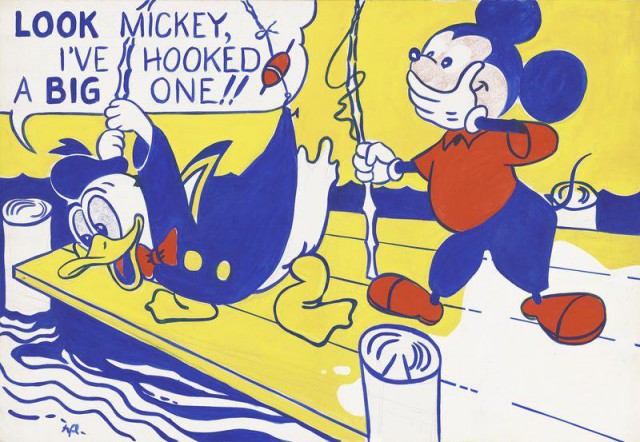
Roy Lichtenstein was born on October 27, 1923, in New York City. In due course, he became one of the most famous artists in history; however, he has had his share of detractors, especially among illustrators. “Lichtenstein did no more or less for comics than Andy Warhol did for soup,” Maus creator Art Spiegelman said in a 2007 interview with Publishers Weekly.
The artist passed away in 1997. In celebration of the late artist’s birthday, we’ve picked our favorite quotes from a 1963 oral history interview between the artist and Richard Brown Baker.
Roy Lichtenstein, The Ring (Engagement) (1962).
Photo: Courtesy Sotheby’s.
On the origins of Pop Art:
We had a meeting and there was some discussion, but not much to do with what to call it. I don1t think any of the artists ever met and decided what to call it at all.
On his purpose:
“My purpose is entirely aesthetic, and relationships and unity are the thing I’m really after.”
Roy Lichtenstein, Look Mickey (1961).
On comic strips:
“The difference between working and not working in an aesthetic way is slight. I think that’s the whole point almost that I’m making because it also relates to the point of copying the comic strip. They look a lot like the original, but really there’s nothing in my work that’s in the same positions really. It’s very similar but it’s not the same…”
On how the medium complicates the message:
“Each particular painting doesn’t communicate, at least in the way that it was meant to in the original comic strip or book.”
On the importance of the present:
“Whether one tries to go back or not, one is always so influenced by present environment that one certainly can’t do Renaissance work today.”
Image: Courtesy Gagosian Gallery.
On his education:
“I don’t think it was a great feeling against school that I had, it was just a minor dislike for school probably no different from most children. But I did sort of average work in school I think, nothing outstanding… I got progressively better as I got older and I did very well in college and then better in graduate school.”
Roy Lichtenstein, Woman with Flowered Hat (1963).
Photo: Courtesy of Christie’s New York.
On Pablo Picasso’s influence:
“You see in the Picasso for someone to draw it neatly and make the face pink which is an obvious idea, this is the kind of insensitivity I want which is humorous insensitivity; I don’t really want to be insensitive to the painting as a work of art…I prefer probably that the art didn’t show immediately…”
On the importance of size:
“I have a variety of canvases and stretchers, and I just—when I pick a subject I try to pick one, a shape that will fit the subject, and somehow or other a size which I think will be—I think if you make certain things too large, you’re making too much of an idea sometimes.”